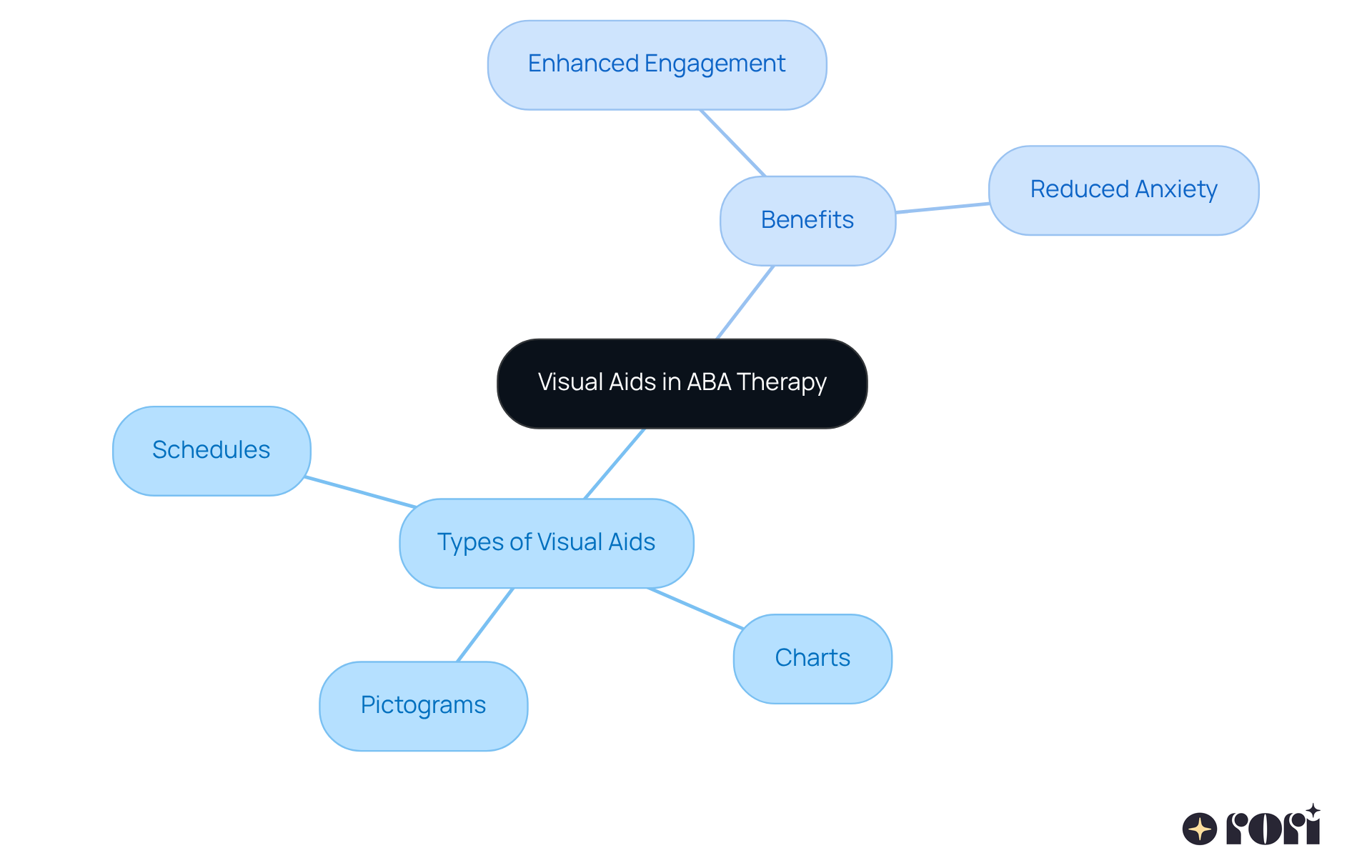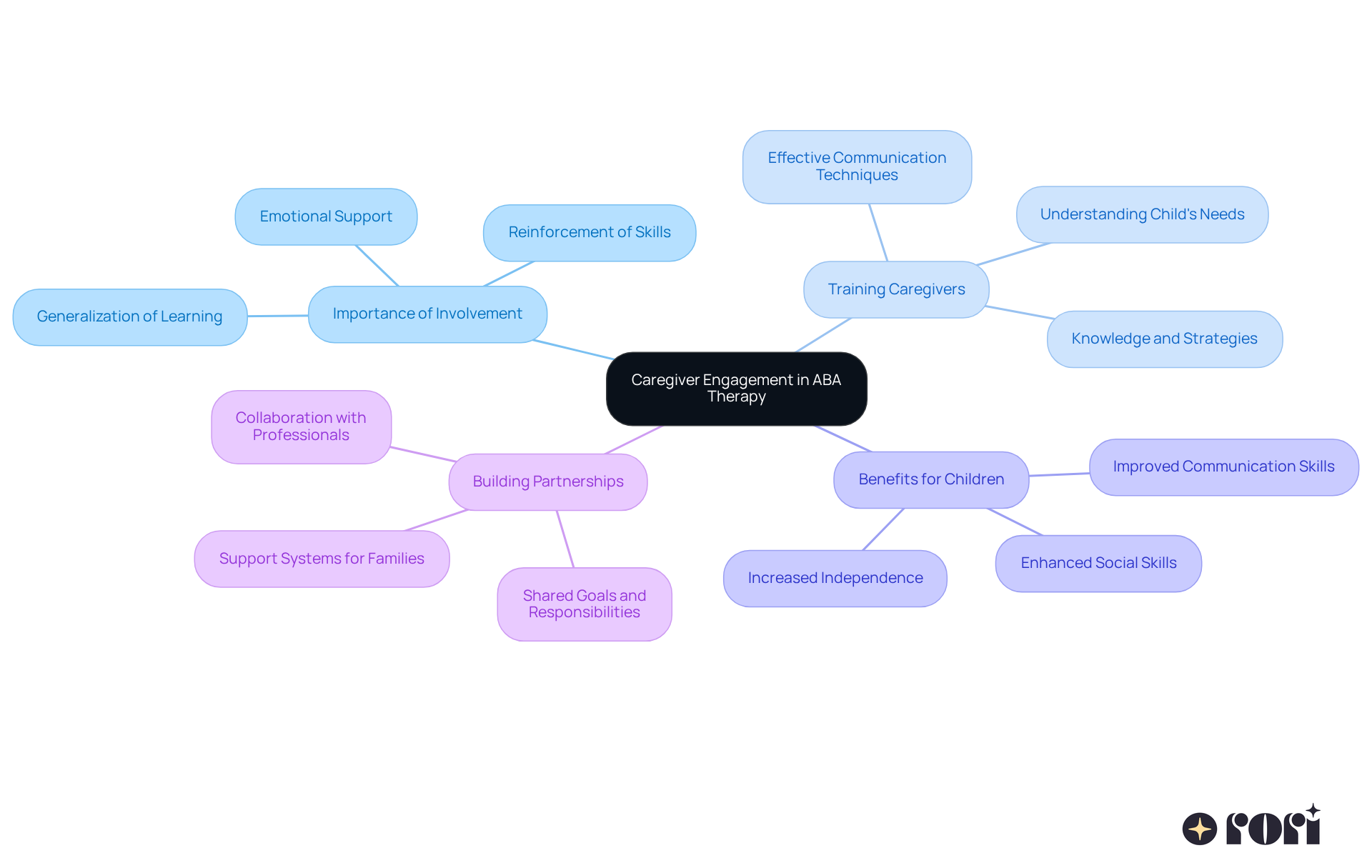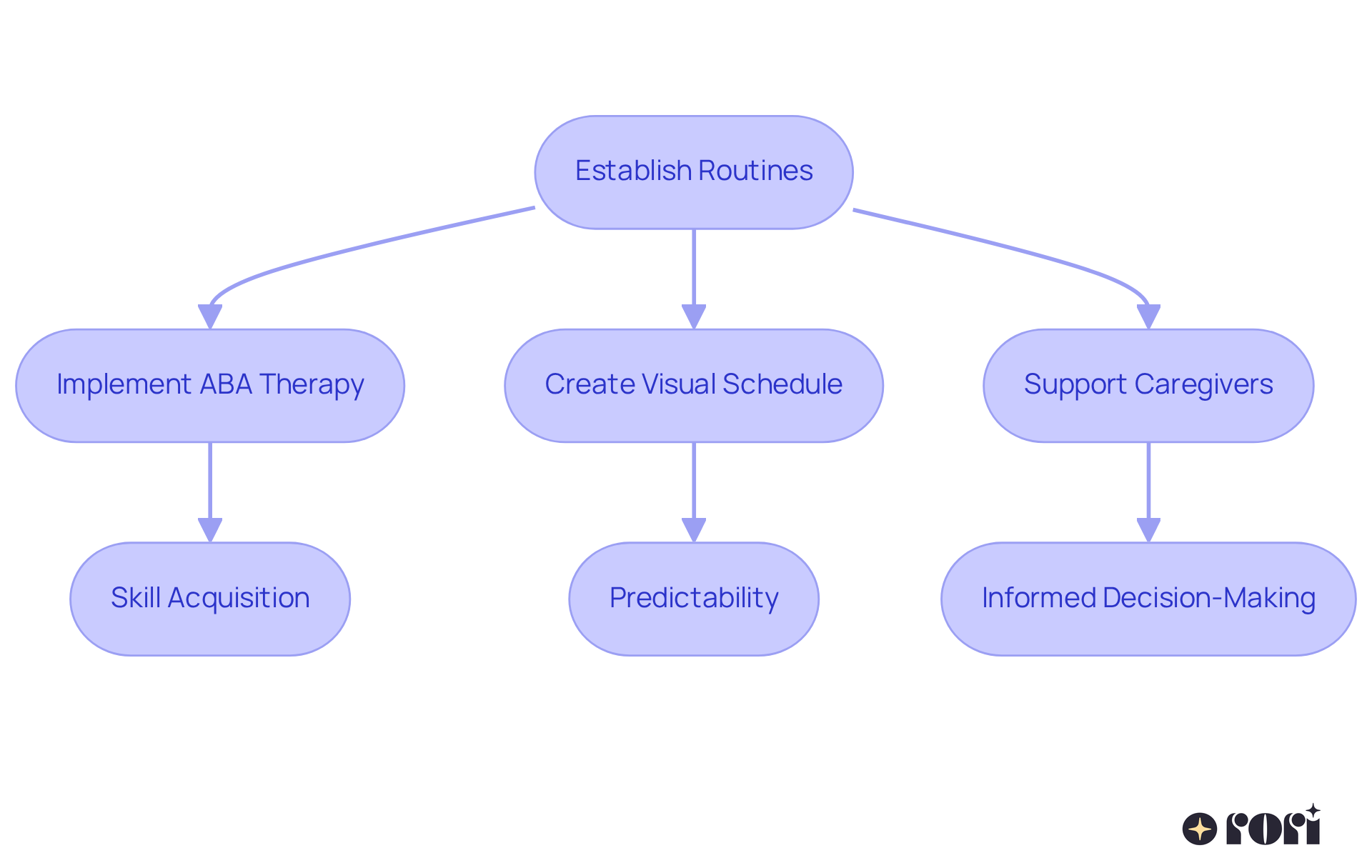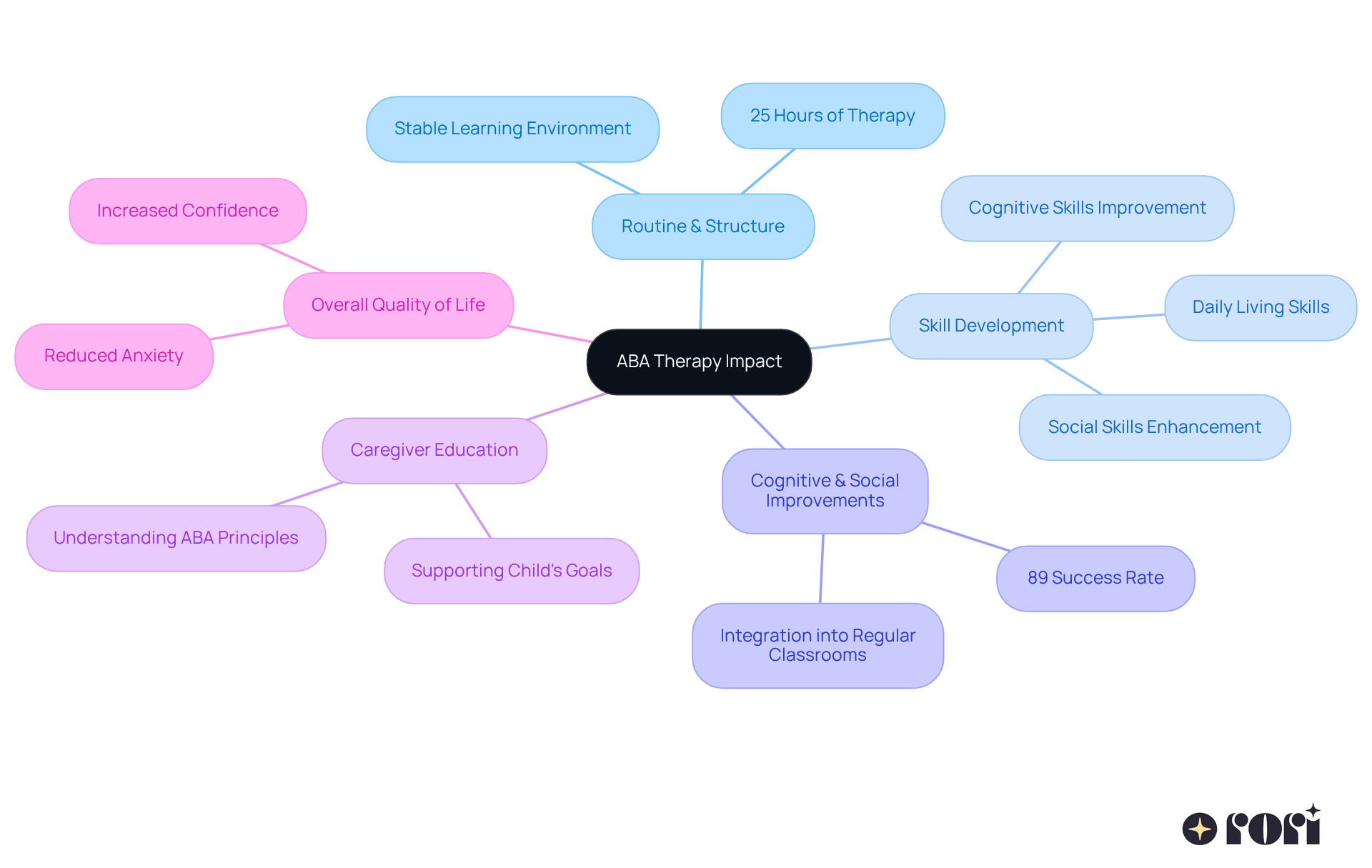ABA therapy has become a beacon of hope for many children with autism, offering structured routines that help them grow and gain independence. By creating personalized routines, this therapy not only tackles behavioral challenges but also nurtures an environment where kids can thrive emotionally and socially.
But how can caregivers effectively tap into these structured approaches to unlock their child's full potential? 🤔 Let’s explore this together! This article dives into ten impactful ways ABA therapy enhances daily life for children, sharing insights and strategies that promise positive outcomes. We’re here to help you every step of the way!
At Rori Behavioral Innovations, we understand that every child is unique, and that’s why we implement ABA therapy for routine and structure to create customized routines tailored just for them. By blending evidence-based methods with the latest technology, our clinicians can craft personalized treatment plans that really make a difference in the effectiveness of ABA.
This personalized touch doesn’t just tackle behavioral challenges; it also nurtures a supportive environment where growth and development can flourish. Imagine seeing transformative results for your child with autism! Our clinicians emphasize that using data analytics allows for real-time adjustments to therapy, ensuring that we’re always tracking and supporting each child’s unique progress effectively.
We’re here to help you every step of the way! Let’s explore this journey together and see how we can make a positive impact on your child’s life.
Aba therapy for routine and structure is essential for kids with autism, offering them the predictability and security they need. At Rori Care, our dedicated clinical leadership team, made up of experienced professionals, is all about promoting neurodiversity and helping young individuals thrive through personalized approaches.
When kids engage in aba therapy for routine and structure, they can better anticipate what comes next. This predictability, facilitated by ABA therapy for routine and structure, can really help reduce anxiety and boost their participation in various activities. Research shows that having organized patterns not only improves emotional well-being but also encourages independence, as kids gain confidence in handling their daily tasks.
By fostering a sense of stability, aba therapy for routine and structure empowers young individuals to flourish, allowing them to develop essential skills and adapt more easily to their environments. Experts agree that consistency, emphasized through aba therapy for routine and structure, is key in creating a supportive atmosphere, leading to better behavioral outcomes and a stronger sense of safety for youth on the autism spectrum.
Let’s explore this together! If you’re looking for ways to implement aba therapy for routine and structure in your child’s life, we’re here to help you every step of the way!
Visual aids, such as schedules, charts, and pictograms, play a crucial role in supporting routine comprehension in ABA therapy. These tools help children visualize their daily activities, making it easier for them to understand what comes next. By incorporating visual supports into therapy, clinicians can enhance engagement and reduce anxiety, allowing children to follow routines with greater ease and confidence.

Caregiver involvement is so important for making ABA intervention work well! When caregivers jump in, they help reinforce the skills learned during therapy sessions, making it easier for kids to carry those lessons into their home life. This teamwork not only boosts a child's grasp of routines but also implements ABA therapy for routine and structure, creating a warm environment that nurtures positive behavior and emotional growth.
You know, studies show that kids who get consistent support from their caregivers really shine in areas like communication and social skills. That’s why training caregivers in ABA methods is key - it gives them the tools they need to provide reliable support, leading to better outcomes for the little ones they care for.
Effective programs understand that the best results happen when families are equipped with knowledge and strategies related to ABA therapy for routine and structure. It’s all about building a partnership that drives progress and success. So, let’s explore this together and see how we can make a difference!

Consistent ABA therapy for routine and structure is essential for helping kids with autism gain independence. When children engage in ABA therapy for routine and structure, they practice regularly within a predictable framework, which helps them develop essential skills for managing daily tasks and making their own choices. This gradual increase in autonomy not only boosts their confidence but also prepares them to tackle future challenges.
Did you know that research shows 50-75% of youngsters receiving intensive Applied Behavior Analysis (ABA) therapy for two or more years see significant improvements in cognitive and adaptive functioning? That’s pretty encouraging! Plus, ABA therapy for routine and structure helps kids navigate their environments more smoothly through organized routines. For instance, ABA therapy for routine and structure can make teaching kitchen safety easier with simple strategies.
The active involvement of caregivers, who understand ABA principles and strategies, really enhances these outcomes. When caregivers are equipped with knowledge, they can make informed decisions that positively impact their child’s progress, leading to better behavioral outcomes.
The long-term benefits of consistent ABA treatment go beyond just learning new skills; they lay a solid foundation for lifelong independence and success. While it can’t reverse autism, it can greatly improve communication, behavior, and independence, ensuring that young individuals are better prepared for the future.
Let’s explore this together! We’re here to help you every step of the way!

Structured teaching is an essential aspect of ABA therapy for routine and structure! It focuses on creating organized learning environments that really make a difference. By using visual supports, clear instructions, and consistent routines, educators can boost educational outcomes for individuals with autism. Isn’t that amazing?
Research shows that early intensive behavioral intervention (EIBI) can lead to significant improvements in cognitive, language, and daily living skills, especially when it’s tailored to individual needs. This organized approach not only helps with academic performance but also encourages social skills growth. It allows young individuals to interact more effectively with their peers and educators.
Plus, a well-structured environment can really help reduce anxiety and create a sense of safety, which is so vital for those on the autism spectrum. By implementing ABA therapy for routine and structure, educators can create a supportive space where young learners can thrive both academically and socially. Let’s explore this together and see how we can make a positive impact!

Aba therapy for routine and structure plays a vital role in easing anxiety for kids with autism. They create a predictable environment that helps kids feel safe and secure. When things are predictable, it can really cut down on those overwhelming feelings that come with unexpected changes. This way, young learners can focus more on their education and engage with their surroundings.
Research shows that having regular practices can significantly boost emotional regulation. This means kids are more open to counseling and social interactions. Experts agree that these predictable frameworks not only support emotional stability but also help kids navigate their daily lives with more confidence.
By incorporating ABA therapy for routine and structure, caregivers can weave structured activities into the process to create a nurturing atmosphere that promotes emotional well-being and encourages active participation in therapeutic tasks. Plus, when caregivers understand ABA principles and strategies, they’re better equipped to provide the right support at home. This complements professional interventions and helps maintain consistency.
When caregivers are actively involved, it leads to better behavioral outcomes. Their engagement aligns with therapeutic strategies, resulting in more effective and lasting improvements. As Temple Grandin wisely said, "Different, not less," highlighting the importance of understanding and supporting the unique needs of individuals with autism.
The case study titled "Establishing Patterns" shows how consistent practices can provide stability and comfort, reinforcing the positive impact of predictability on emotional regulation. And let’s not forget about visual supports, like picture schedules! They can really enhance the efficiency of activities, helping kids grasp expectations and manage their daily tasks with ease.
Let’s explore this together! We’re here to help you every step of the way!

Creating consistent practices during early intervention is so important for helping individuals with autism thrive. When we implement ABA therapy for routine and structure, young ones can pick up essential skills more effectively through structured schedules and consistent routines. Think about it: regular support not only helps kids adjust to their surroundings but also enhances their learning experiences, laying the groundwork for future successes in various areas of life.
And here’s something to consider: using ABA therapy for routine and structure can really empower caregivers. It gives you the tools and strategies you need to support your child’s unique behavioral goals. This active involvement not only fosters informed decision-making but also leads to better behavioral outcomes, which is a win for the whole family!
To further support your child, why not create a visual schedule that outlines daily activities? This can help them understand and anticipate transitions, making the day feel a bit more predictable. Let’s explore this together! We’re here to help you every step of the way!

Structured play is such a crucial part of ABA therapy, especially when it comes to helping kids with autism develop their social skills. Through fun, goal-oriented play activities, children get to interact with their peers, share, and take turns. This not only builds essential communication skills but also boosts their confidence and emotional regulation - both key ingredients for effective social engagement.
For example, play-based interventions have been linked to longer attention spans and less anxiety, creating a more welcoming environment for learning. Isn’t that amazing? Plus, studies show that kids who engage in structured play often see significant improvements in their social competence. They learn to navigate social dynamics through guided interactions, which is so important!
This approach doesn’t just help kids develop foundational social skills; it also empowers them to express themselves and form meaningful relationships. Ultimately, this can really enhance their overall quality of life. Parents and caregivers, you can play a big role too! Try participating in organized play activities at home, focusing on skills like turn-taking or sharing. It’s a great way to strengthen those vital social abilities and support your child’s development. Let’s explore this together!

ABA intervention can truly transform the lives of kids with autism! By creating organized patterns, it provides a stable structure for learning and behavior that is crucial in ABA therapy for routine and structure. This structured approach, including ABA therapy for routine and structure, is crucial for skill development, helping young learners tackle daily tasks with much more ease.
Did you know that kids who receive at least 25 hours of ABA therapy each week show significant improvements in cognitive skills and social abilities? This really highlights how consistency can promote independence! Plus, these organized patterns help reduce anxiety, allowing kids to feel more secure and confident in their surroundings.
The positive changes that young individuals and their families experience underscore just how vital ABA therapy for routine and structure is for achieving meaningful progress. It can truly enhance their overall quality of life. And let’s not forget about caregiver education! It’s essential for the success of ABA therapy. When families are equipped with a deeper understanding of ABA principles and strategies, they can support their child’s learning and behavioral goals more effectively.
By making informed decisions, caregivers can positively impact their child's progress, leading to better behavioral outcomes and improved family dynamics. So, let’s explore this together! We’re here to help you every step of the way!

Implementing ABA therapy with a focus on routine and structure brings wonderful benefits for children with autism. This approach creates a predictable environment that not only fosters security and reduces anxiety but also helps children develop essential skills for independence. By customizing routines to fit each child's unique needs, ABA therapy paves the way for significant progress in their daily lives and overall well-being.
Throughout this journey, it’s clear that personalized routines, the use of visual aids, and the active involvement of caregivers play crucial roles in reinforcing learned skills. Structured teaching and play enhance educational outcomes and social skills, creating a nurturing atmosphere where children can truly thrive. The evidence shows that consistent ABA therapy can lead to meaningful improvements in communication, behavior, and emotional regulation, ultimately laying a solid foundation for lifelong success.
The importance of routine in ABA therapy is something we can’t overlook. It’s a vital tool for managing anxiety, promoting independence, and enhancing the quality of life for children with autism. As caregivers and educators embrace these strategies, they can create a supportive environment that nurtures growth and fosters a brighter future for the children they care for. Engaging with ABA therapy not only transforms individual lives but also strengthens family dynamics, making it an invaluable approach for those looking to make a positive impact.
Let’s explore this together! By embracing these strategies, we can create a community of support and understanding. We’re here to help you every step of the way!
What is Rori Care's approach to ABA therapy?
Rori Care implements ABA therapy through personalized routines tailored to each child's unique needs, blending evidence-based methods with the latest technology to create effective treatment plans.
How does personalized ABA therapy benefit children with autism?
Personalized ABA therapy addresses behavioral challenges while nurturing a supportive environment for growth and development, leading to transformative results for children with autism.
What role does data analytics play in Rori Care's therapy?
Data analytics allows clinicians to make real-time adjustments to therapy, ensuring effective tracking and support of each child's unique progress.
Why are structured routines important for children with autism?
Structured routines provide predictability and security, which help reduce anxiety and boost participation in activities, ultimately improving emotional well-being and encouraging independence.
How does ABA therapy promote neurodiversity?
Rori Care's clinical leadership team focuses on personalized approaches that promote neurodiversity, helping young individuals thrive and develop essential skills.
What are the benefits of using visual aids in ABA therapy?
Visual aids, such as schedules and charts, help children visualize daily activities, enhancing engagement, reducing anxiety, and making it easier for them to follow routines with confidence.